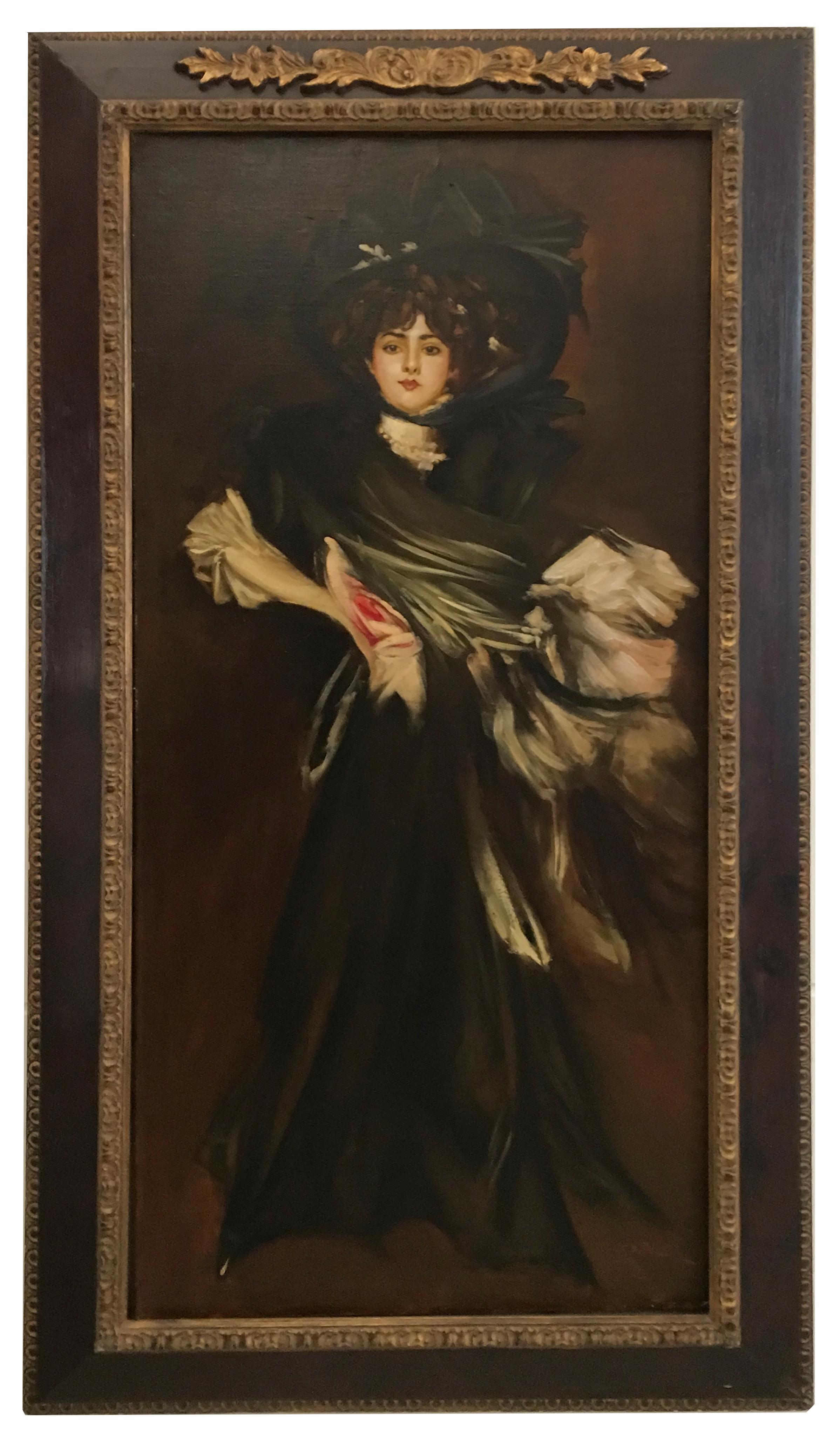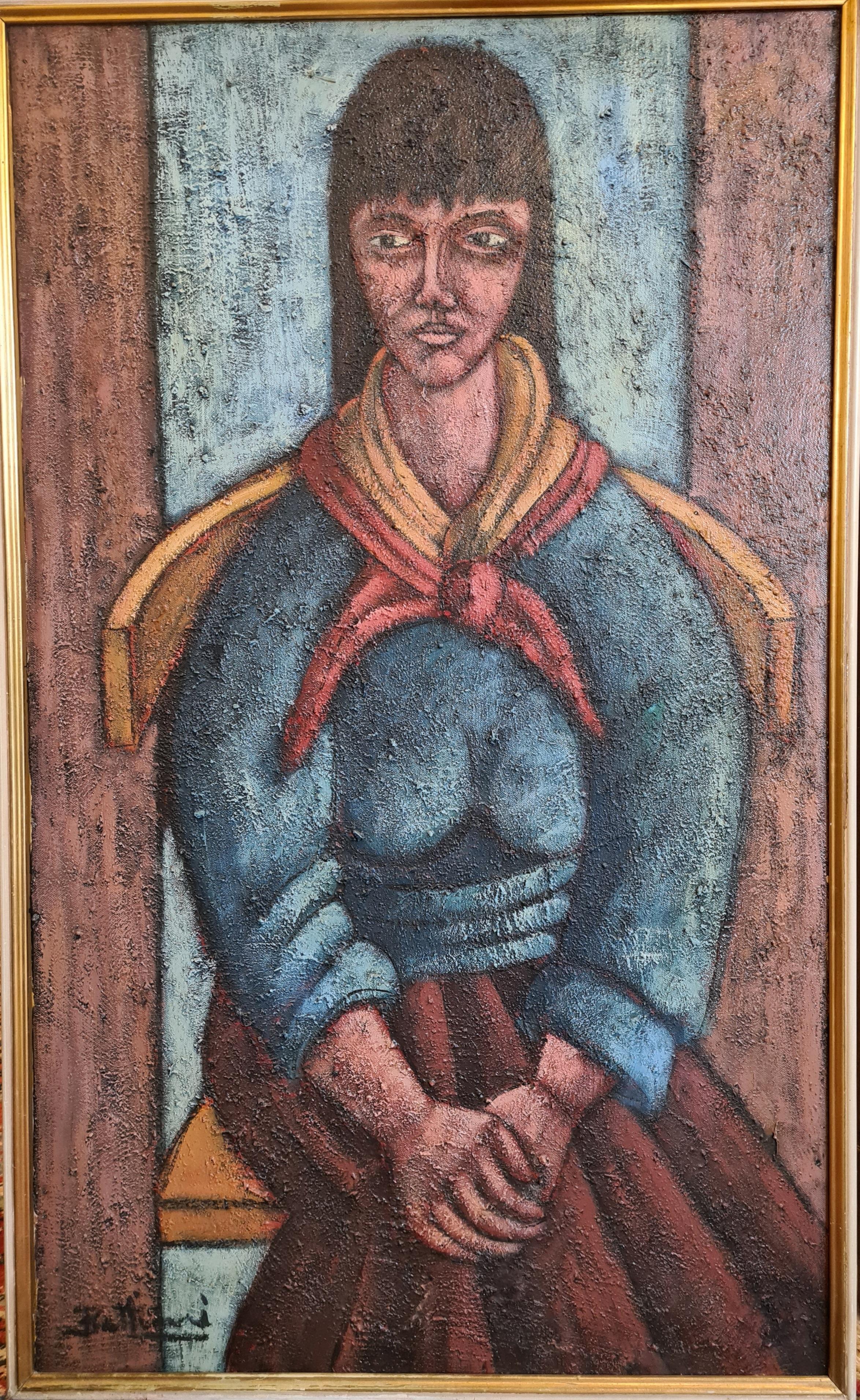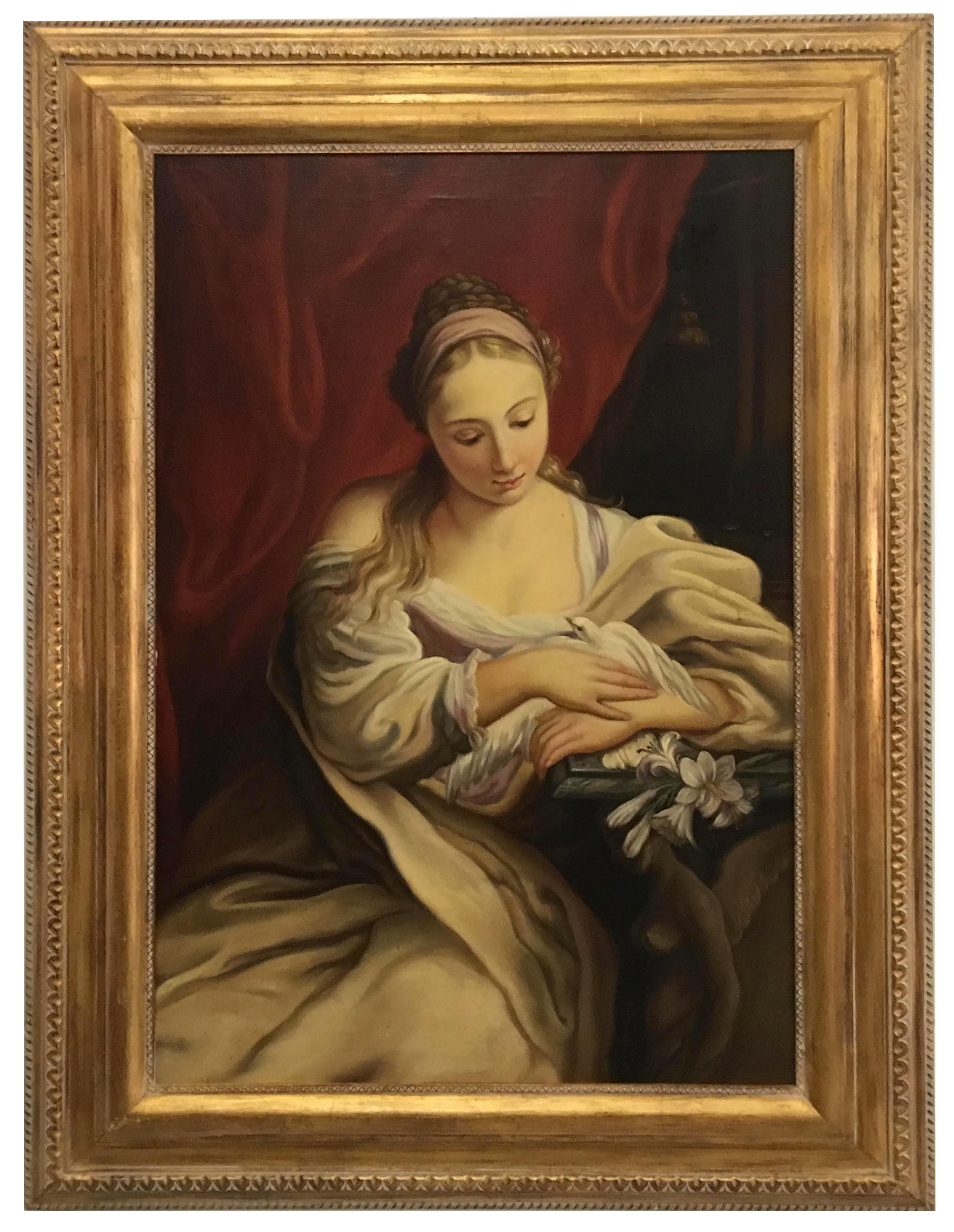Items Similar to Attilio Manganaro (c.1865-c.1890) - Portrait of Gabriele d’Annunzio in 1887
Want more images or videos?
Request additional images or videos from the seller
1 of 9
Attilio ManganaroAttilio Manganaro (c.1865-c.1890) - Portrait of Gabriele d’Annunzio in 18871887
1887
About the Item
Attilio MANGANARO
(c.1865 – c.1890)
Portrait of Gabriele d'Annunzio in 1887
Oil on canvas
H. 52 cm; L. 42 cm
Signed and dated lower right 1887
On the frame an inscription in Italian indicating that the painting was painted at the time of the book "L'Armata d'Italia" by d'Annunzio, 1887-1888
Our portrait is an extremely rare original artistic iconography by Gabriele d'Annunzio (1863, Pescara – 1938, Gardone Riviera) perhaps the earliest known to date.
We have a photograph of d'Annunzio as a teenager (the poet gave a dedicated version to the actress Cécile Sorel), and another of him as a young man, without a mustache and with rather abundant hair, probably dating from a shortly before (a few years?) our painting. Another photograph represents him a priori at the age of 25, in 1888; this photo serves as the basis for an illustration published in particular in “L’Illustrazione Italiana” in August 1889; he then has a mustache with the ends smoothed and raised, and a hairstyle already a little less provided. A photograph by his friend the painter Francesco Paolo Michetti (1851-1929) shows him on the beach at Francavilla, getting out of the bath, with a somewhat messy mustache but resembling that of the previous photo, at the age of 25 years (photo taken in September 1888).
Concerning the original works of art (drawing, painting, sculpture), it is the bust executed by Paul Troubetzboy (1866-1938) which seems, apart from ours, to be the first effigy of d'Annunzio; the Russian artist came to Naples in 1891 to create a monument to the glory of Garibaldi, and he met d'Annunzio there who stayed there between the end of 1891 and the end of 1893, the two artists forging a long-term friendship there . On this bust, datable to 1892, the Italian poet now wears a pointed goatee, in addition to his raised mustaches.
In 1895, d'Annunzio was portrayed by Michetti; in addition to several photos taken in the painter's studio, there is a drawing (40 x 30 cm) in charcoal, where he always appears with a raised goatee and mustache, but also with the onset of pronounced baldness.
However, it is possible that Michetti made other portraits of d'Annunzio, their friendship dating back to the early 1880s. de Pescara), in the Franciscan convent of Santa Maria del Gesu, which Michetta bought in 1885.
At the time of our portrait, d'Annunzio was living in Rome, where he came to complete his studies from November 1881. He had already published collections of poems: Primo Vere in 1879, Canto Novo in 1882, collections of short stories (The Book of Virgins in 1884 and Saint Pantaléon in 1886), which earned him a certain notoriety, particularly in aristocratic and intellectual circles. He had an intense social activity, and became a contributor to the newspaper "La Tribuna" (founded by Prince Maffeo Barberini Colonna di Sciarra) at the end of 1884, in which he often wrote under the pseudonym of "Duca Minimo". Important salon character, brilliant journalist, he also has the reputation of an irresistible seducer, even if he has been married since 1883, and 1887 also marks the beginning of an affair with Barbara Léoni which will last five years.
In September 1887, he took a cruise on the Adriatic aboard the yacht of his friend Adolfo de Bosis, a cruise that turned into a mishap following which the passengers were rescued by a Navy battleship. Interviews with the officers of the battleship lead d'Annunzio to delve into the problems of the Italian Navy, and he then writes a series of controversial articles (the recipient is Admiral and Minister Benedetto Brin), heroic in tone and nationalist, in which he asks for the reinforcement and a better organization of the Italian fleet (the Armata). These political articles will be published in "La Tribuna" from May 27 to July 6, 1888 and then published the same year under the title "L'Armata d'Italia", one of the least known works of the Italian poet today.
It was probably in this journalistic and nationalist context that d'Annunzio met the author of his portrait, Attilio Manganaro.
Of this artist we know very little. He is the son of the famous nationalist painter, illustrator and caricaturist Antonio Francesco Paolo Manganaro (1840, Manfredonia – 1931, Naples). The latter, a great patriot and lover of freedom, was one of the members of the secret action committee of 1859 and actively participated in the revolutionary uprisings of 1860 against the Bourbons, where he distinguished himself alongside Garibaldi by his bravery and his audacity. Subsequently he was hired as a caricaturist by Alessandroni, editor of the newspaper "L'Arche de Noé". Considered one of the main caricaturists of the time with Errico Colonna and Melchiorre Delfico, he obtained in 1885 the chair of drawing at the technical school "Giambattista della Porta" in Naples.
Antonio Manganaro had two sons, Alberto and Attilio, both painters, who died very young, and were close like their father to nationalist circles linked to the Risorgimento. Attilio is moreover described, in the epitaph on his father's tombstone, as a "genius of painting", which the almost total ignorance of his corpus does not allow us to judge. We do know, however, that Attilio was also an illustrator for the press and that he worked for the humorous weekly "Il bello Gaspare" (founded in Naples in 1878), alongside other nationalist artists such as Edoardo Matania (1847-1929 ) and Gennaro Amato.
It was therefore at a pivotal period in d'Annunzio's career, where he was certainly known, but just before the fame that the publication of his first novel Il piacere (The child of pleasure in French) would bring him in 1889, what is done this portrait all in intimacy and half-light, testimony of an artistic encounter in the Roman nationalist circles of the 1880s.
- Creator:Attilio Manganaro (1865 - 1890, Italian)
- Creation Year:1887
- Dimensions:Height: 20.48 in (52 cm)Width: 16.54 in (42 cm)
- Medium:
- Movement & Style:
- Period:
- Condition:Perfect condition. Cleaned.
- Gallery Location:BELEYMAS, FR
- Reference Number:1stDibs: LU186029879242
About the Seller
No Reviews Yet
Vetted Seller
These experienced sellers undergo a comprehensive evaluation by our team of in-house experts.
Established in 2011
1stDibs seller since 2022
- ShippingRetrieving quote...Ships From: BELEYMAS, France
- Return PolicyThis item cannot be returned.
More From This SellerView All
- Men portraitBy Giovanni Maria delle Piane dit Mulinaretto (Genoa 1670 - Monticelli d´Ongina 1745)Located in BELEYMAS, FRGiovanni Maria DELLE PIANE, known as IL MULINARETTO (Genoa, 1660 – Monticelli d'Ongina, 1745) Portrait of a man Oil on oval canvas H. 108 cm; L. 83 cm Provenance: Nino Ferrari Colle...Category
1730s Italian School Figurative Paintings
MaterialsCanvas, Oil
- Portrait of Robert Duflos de Saint-Amand (1812-1894) French consulLocated in BELEYMAS, FRPortrait of Robert Duflos de Saint-Amand (1812-1894), Consul of France Oil on canvas H. 91 cm; W. 72 cm From a family of the Parisian bourgeoisie, Robert Duflos de Saint-Amand was ...Category
1880s French School Figurative Paintings
MaterialsCanvas, Oil
- Presumed portrait of Princess de Conti, Marie-Anne de BourbonBy Nicolas de LargillièreLocated in BELEYMAS, FRNicolas de LARGILLIERRE (Paris 1656 – 1746) Portrait of a woman, presumed to be Marie-Anne de Bourbon, Princess of Conti (1666-1739) Oil on oval canvas H. 80 cm; L. 61 cm (107 x 91 c...Category
1730s French School Figurative Paintings
MaterialsCanvas, Oil
- Sketch of a dandy portraitLocated in BELEYMAS, FRFrench school circa 1840 Sketch of a dandy portrait Oil on canvas mounted on cardboard H. 21 cm; L. 20.5 cmCategory
1830s French School Figurative Paintings
MaterialsCanvas, Oil
- Portrait of a man in armorLocated in BELEYMAS, FRAttributed to Jacques DUMONT aka DUMONT LE ROMAIN (Paris 1701 - 1781) Presumed portrait of Louis-Joseph de Formanoir (?-1732) Oil on canvas H. 91.5 cm; ...Category
1750s French School Figurative Paintings
MaterialsCanvas, Oil
- Charles Fréchou - Child portrait with a catLocated in BELEYMAS, FRCharles FRÉCHOU (Paris 1820 – Paris 1900) Portrait of a child with a cat Oil on canvas H. 41 cm; L. 33 cm Signed lower left and dated 1849 Apart from participation in the Salon betw...Category
1810s French School Figurative Paintings
MaterialsCanvas, Oil
You May Also Like
- LADY'S PORTRAIT - Venetian School - Oil on Canvas Italian Figurative PaintingBy Giovanni SantanielloLocated in Napoli, ITLady's portrait - Giovanni Santaniello Italia 2002 - Oil on canvas cm. 100 x 80 The painting by Giovanni Santaniello depicts a portrait of a beautiful pensive woman in elegant clothe...Category
Early 2000s Italian School Portrait Paintings
MaterialsOil, Canvas
- LADY IN BLACK-In the Manner of G. Bodini Italy figurative oil on canvas paintingBy Eugenio De BlasiLocated in Napoli, ITLADY IN BLACK - Oil on canvas painting, Eugenio De Blasi, Italy, 2011 This is his reinterpretation of a greatest old master painting by Giovanni Boldini. Gold leaf gilded and mohogan...Category
Early 2000s Italian School Figurative Paintings
MaterialsOil, Canvas
- Woman Seated in a Klismos Chair. Italian School, Transavantgarde Oil on Canvas.Located in Cotignac, FRMid 20th Century Italian portrait of a seated lady signed Battionni bottom left. Presented in a white and gilt wood frame. A characterful stylised...Category
Mid-20th Century Italian School Figurative Paintings
MaterialsCanvas, Oil
- PORTRAIT OF YOUNG WOMAN - Venetian School -Italian oil on canvas paintingBy Eugenio De BlasiLocated in Napoli, ITPORTRAIT OF YOUNG WOMAN - Oil on canvas painting cm.95x65, Eugenio De Blasi, Italy, 2008 The painting by Eugenio De Blasi is inspired by the work of the Venetian painter and portrai...Category
Early 2000s Italian School Figurative Paintings
MaterialsCanvas, Oil
- AUTUMN'S ALLEGORY - Eugenio De Blasi - Italian Portrait Italian Oil on CanvasBy Eugenio De BlasiLocated in Napoli, ITAutumn's Allegory - Oil on canvas cm.60x50, Italia, 2007, Eugenio De Blasi (3c59a) The painting by Eugenio De Blasi is an autumn allegory inspired by the allegorical figures of the ...Category
Early 2000s Italian School Portrait Paintings
MaterialsCanvas, Oil
- SCENE WITH MINSTREL- Eugenio De Blasi - Italy -Oil on canvas paintingBy Eugenio De BlasiLocated in Napoli, ITScene with Minstrel - Oil on canvas painting, Eugenio De Blasi, Italy, 2005 This is his reinterpretation of a greatest old master painting by Giovanni Boldini.Category
Early 2000s Italian School Figurative Paintings
MaterialsCanvas, Oil
Recently Viewed
View AllMore Ways To Browse
Bourbon Art
Russian Man Portrait
Portrait Of A Russian Man
Painting Of Santa Maria
Painting Of French Riviera
Effigy Art
Antique Navy Paint
Italy Cruise
Paolo C
Antique School Chairs
Antique School Chair Chairs
Antique School Chair
French Riviera Painting
Antique Chair Drawing
French Painted Period Chair
Effigy Sculpture
Antique Rescue
Prince Chair





